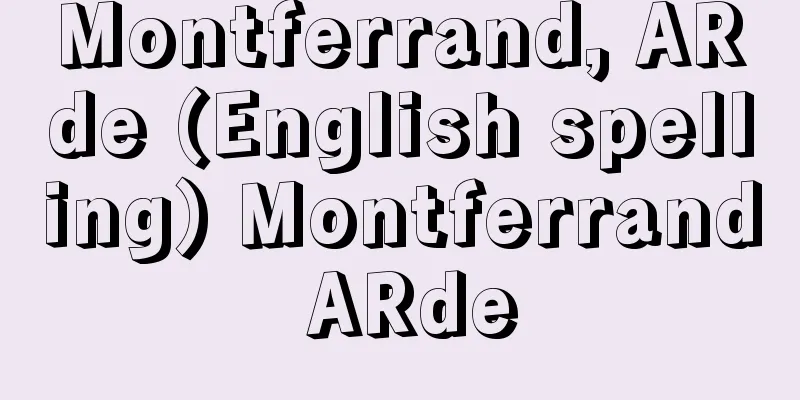The Tale of Tsutsumi Chunagon

|
It consists of ten short stories written in the late Heian period and one fragment that is just the beginning of a story. Of the stories, "Gon Chunagon Who Doesn't Go Beyond Osaka" is known to have been submitted by a lady-in-waiting named Koshikibu to a story-writing contest held at the home of Princess Saiin Saishi in Rokujo on the night of May 3, 1055 (Tenki 3), according to the description of a poetry contest in the 20-volume "Ruijū Utaawase" held by the Yomei Bunko. However, the authors and writing dates of the other stories are unclear, but judging from their contents, they are thought to have been written around the same time or slightly later. However, it is unclear when these stories were compiled into their current form, and the origin of the title that includes Tsutsumi Chunagon. Since five of the ten waka poems are included in the "Fuyo Wakashu" compiled in 1271 (Bun'ei 8), some theories suggest that it was written around this time, while others suggest that it was written between 1390 and 1427 (around the time of the Meitoku and Oei periods) because a surviving copy of "Yoshinashigoto" states in the colophon that it was copied in 1385. There is also a theory that the editor was Nijō Yoshimoto (1320-1388), but the evidence is weak. There are also many unusual theories about the title, such as one that Fujiwara Kanesuke (879?-933), a famous poet also known as Tsutsumi Chunagon, was assigned to each of the protagonists in the various stories, one that there was a book that began with "Gon Chunagon who does not cross Osaka" and the abbreviated title "Gon Chunagon" was a misprint, and another that when the 10 stories were packed together, the words "One Tale" were written on the wrapping paper, which became the title, but in short, it is completely unclear. Therefore, there are five different arrangements in the extant versions, which are probably due to the fact that the original format was 10 volumes of 10 stories, so it is difficult to gauge the intention behind them, but I will outline the rough outlines of each story based on the order in which the books are commonly read. [The Shosho who Breaks Cherry Blossoms] A tale of failure in which the protagonist tries to steal away a princess he has caught a glimpse of, but ends up bringing the princess's grandmother, a nun who has been worried about her, into his carriage. [Next] The story is told by three ladies-in-waiting, and includes the story of a man who was attracted to the singing of a princess with whom he had a child and decided to stay, the story of a woman who hated the world and who he saw at Kiyomizu Temple, and the story of a young woman who became a nun and was seen at a nunnery in Higashiyamabe. [The Princess Who Loved Insects] The princess collected creepy insects, especially caterpillars, and she never wore makeup and always talked nonsense, which left the men speechless. [Moderate Love] The story of love between men and women of different social classes: a young servant boy and a young girl, a young man and his wife, and their two masters, the Head Chamberlain and a princess. [The Gon Chunagon did not cross Osaka] The side on which the talented and handsome Gon Chunagon sided was naturally victorious in the iris root battle, but the princess whom he loved, although she had snuck into his bedroom, refused to submit to his wishes until morning. [Shell Battle] Taking a glimpse of the motherless princess, the junior general of the Kurodo clan feels sympathy for her and secretly presents her with a variety of beautiful shells, helping her to turn a losing battle with a princess from the northern flank into victory. [The Shosho ends up in an unexpected place] While two sisters were passing by one another, one to a Shosho who was the son of the General of the Right and the other to a Shosho who was the son of the Minister of the Right, they misunderstood each other and ended up making love to the wrong man. [Hanada no Nyōgo] Hearing that twenty or so sisters had gathered together after returning from their duties at the palace, the lover went to take a look and heard them talking about their mistresses, comparing them to flowers. None of them responded to his song of invitation. [Haizumi] When a man announces that he is taking a new lover, an orphan woman leaves the house, but the man feels sorry for her and calls her back. When the man returns after a long time, his lover mistakes ink powder for face powder and smears it on his face. [Trivia] An introduction to a letter in which a monk writes a list of bizarre and fantastical items to a woman who has become his devotee, saying that she would like to borrow them. It is a collection of short stories with misunderstandings, plot twists, unusual protagonists, and even some tears, and among the mid- to long-form stories of the Heian period, these works stand out for their emphasis on wit rather than emotion. There are no extant copies dating back to the early Edo period, so there are many problems with the text. [Ikeda Toshio] "Japanese Classical Literature Series 13: Ochikubo Monogatari and Tsutsumi Chunagon Monogatari," edited by Matsuo Satoshi and Teramoto Naohiko (1957, Iwanami Shoten)" ▽ "Complete Translation of Japanese Classics 27: Tsutsumi Chunagon Monogatari and Mumyo-zoshi," edited and translated by Inaga Keiji and Kuboki Tetsuo (1987, Shogakukan)" ▽ "Toki Takeharu, A Study of Tsutsumi Chunagon Monogatari" (1967, Kazama Shobo)" ▽ "Suzuki Kazuo, An Introduction to Tsutsumi Chunagon Monogatari" (1980, Ohfusha)" [Reference] |Volume 3 "The Princess Who Loved Insects" (manuscript held at the National Diet Library ) "The Tale of Chunagon Tsutsumi" Source: Shogakukan Encyclopedia Nipponica About Encyclopedia Nipponica Information | Legend |
|
平安後期成立の短編物語10編と、物語冒頭部のみの断章一つとよりなる。各物語のうち、「逢坂越(おうさかこ)えぬ権(ごん)中納言」は、陽明文庫蔵20巻本『類聚歌合(るいじゅううたあわせ)』所収の歌合の記載によって、1055年(天喜3)5月3日夜、六条斎院禖子(さいいんばいし)内親王家で催された物語合(あわせ)のおり、宮に仕える小式部(こしきぶ)という女房が提出した物語であることが判明している。しかし、ほかの物語はすべて作者も執筆時期も明らかでないが、内容から判断して、同じころか、それよりやや下るころの成立と考えられる。ただ、これらを現在のような形にまとめた時期と、堤中納言を冠した題名の由来がつまびらかでない。1271年(文永8)成立の『風葉(ふうよう)和歌集』に、10編のうち5編までの和歌が収録されているので、この前後かとする説と、「よしなしごと」一編の奥書に元中(げんちゅう)2年(1385)書写と記す伝本があることから、1390年から1427年(明徳・応永ごろ)とする説などあり、確定しない。編者を二条良基(よしもと)(1320―1388)と擬する説もあるが、根拠が薄弱である。また題名は、堤中納言とよばれた著名な歌人、藤原兼輔(かねすけ)(879?―933)を諸編中の各主人公に付会したとする説や、「逢坂越えぬ権中納言」を冒頭に据えた本がかりにあったとして、その略称「権中納言」が誤記されたとする説、10編を一包みにしておいた際、包紙に「物語、一つつみ」と書いたのが題名となったとする説など、奇抜な説も多いが、要するにまったくわからない。したがって、配列は、現存伝本によって5通りもあり、おそらく10篇(ぺん)10冊本を原形としたために生じたと思われるので、その意図は計りかねるが、通行本の順序により、各編の荒筋を述べる。 〔花桜折る少将〕垣間見(かいまみ)をした姫君を盗み出そうとした主人公が、姫君を案じてきていた祖母の尼君(あまぎみ)を車に乗せてきてしまう失敗譚(たん)。 〔このついで〕3人の女房が語り継ぐ構成で、子までなした姫君の歌にひかれて居着くようになった男の話、清水(きよみず)寺で見聞した世を厭(いと)う女の話、東山辺の尼寺で見た若い女の出家した話。 〔虫めづる姫君〕うす気味わるい虫を集め、とくに毛虫を好む姫君は、化粧もせず理屈ばかりこねるので、男たちも閉口した。 〔ほどほどの懸想〕小舎人童(ことねりわらわ)と女童(めのわらわ)、若い男と女房、2人の主人である頭中将(とうのちゅうじょう)と姫君という、階層の異なる男女が織り成す恋の顛末(てんまつ)。 〔逢坂越えぬ権中納言〕才気もあり容姿も端正な権中納言が加担した側は、菖蒲(あやめ)の根合(ねあわせ)でもむろん勝ったが、その中納言が想(おも)う姫君は、寝所に忍び込まれながら、朝までついに意に従わなかった。 〔貝あはせ〕母のない姫君を垣間見て同情した蔵人(くろうど)の少将は、姫君が、北の方腹(かたばら)の姫君と争う貝合の劣勢を、ひそかにさまざまなすばらしい貝を贈って勝利に導く。 〔思はぬ方にとまりする少将〕姉妹がそれぞれ、右大将(うだいしょう)の子の少将と右大臣の子の少将とを通わせているうち、手違いから相手を取り違えて契ってしまった。 〔はなだの女御〕宮仕えから里帰りをした姉妹が二十幾人も集まっていると聞き、垣間見に出向いた好き者は、彼女たちがそれぞれの女主人を花に例えて話をしているのを聞いた。彼の誘いの歌にはだれも応じなかった。 〔はいずみ〕男が新しい愛人を迎えるというので、身寄りのない女は家を去ったが、男はあわれを感じて呼び戻した。久しぶりに男が訪れると、愛人は白粉(おしろい)と間違えて掃墨(はいずみ)を顔に塗ってしまう。 〔よしなしごと〕帰依(きえ)する女に、僧侶(そうりょ)が借りたい品といって、奇想天外な物を次々と書き並べた手紙の紹介。 行き違いあり、どんでん返しあり、珍妙な主人公あり、涙もあるという短編物語集で、中・長編を主とする平安時代物語のなかでは、情的世界より、むしろ機知を重んじた異彩を放つ作品群である。江戸初期をさかのぼる伝本がないので、本文上は問題が多い。 [池田利夫] 『松尾聰・寺本直彦校注『日本古典文学大系13 落窪物語・堤中納言物語』(1957・岩波書店)』▽『稲賀敬二・久保木哲夫校注・訳『完訳日本の古典27 堤中納言物語・無明草子』(1987・小学館)』▽『土岐武治著『堤中納言物語の研究』(1967・風間書房)』▽『鈴木一雄著『堤中納言物語序説』(1980・桜楓社)』 [参照項目] |巻3 「虫めづる姫君」 写本国立国会図書館所蔵"> 『堤中納言物語』 出典 小学館 日本大百科全書(ニッポニカ)日本大百科全書(ニッポニカ)について 情報 | 凡例 |
>>: Wrapping paper - Tsutsumigami
Recommend
Weichsel
…The term Prussia in its broadest sense refers to...
Oxytocin Preparation - Oxytocin Preparation
…Mental stress and pain impair the mechanism of m...
São Paulo (State)
Located in southeastern Brazil, it is the state th...
Gyotokugashi
...To prevent the spread of fires, there were str...
Bedwetting - Bedwetting
Among enuresis, which is when you urinate unconsc...
Mount Ajara
...The springs are gypsum springs with temperatur...
Clermont-Ferrand
The capital of the Puy-de-Dôme department in centr...
Kunene, M.
...It is noteworthy that writers in the post-colo...
Thomas Bewick
1753‐1828 English illustrator and printmaker, espe...
Stroke - Scratch
〘 noun 〙 The strokes of a character. Strokes in a ...
Kirigami
How paper was used for ancient documents. Paper t...
Pinnipeds - Pinnipedia
A general term for animals in the order Carnivora,...
Tonic convulsions - Tonic convulsions
…It refers to an involuntary and sudden muscle co...
Balanus reticulatus (English name: Balanus reticulatus)
A crustacean of the Cirripedidae family (illustrat...
Noble - Kika
…This is a breeding method often used to genetica...



![Otis [company] - Otis](/upload/images/67cfd36e19ed5.webp)





